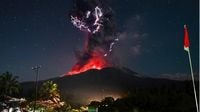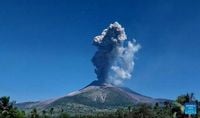Flights in and out of Indonesia’s most popular tourist destination, Bali, ground to a halt this week after Mount Lewotobi Laki-laki, a volcano on Flores Island in East Nusa Tenggara province, erupted with dramatic force. The eruption began at 5:35 p.m. local time on October 1, 2025, sending a towering ash column—measured at 6.8 miles (11 kilometers) high—over the island, according to Indonesia’s Geology Agency and the Volcanology and Geological Disaster Mitigation Center (VGDMC), as reported by SyndiGate Media Inc. and other outlets.
Eyewitnesses described a surreal, mushroom-shaped orange cloud engulfing the nearby village of Talibura, while thick gray ash drifted west and northwest of the crater. Ashfall was reported as far as 93 miles (150 kilometers) away, blanketing communities and raising immediate health concerns. In response, Indonesia’s authorities wasted no time: the highest volcano alert was issued, and both tourists and residents were urgently advised to stay well clear of the area surrounding the volcano.
The eruption’s timing—during the height of tourist season—caused widespread chaos for travelers. Bali’s Denpasar International Airport, a hub for both domestic and international flights, reported extensive disruptions. Flights to Jakarta and Lombok were canceled, as were connections to major destinations in Australia, China, India, Malaysia, New Zealand, and Singapore. Singapore’s Changi Airport reflected the turmoil, with Jetstar and Scoot canceling their Wednesday morning flights to Bali and AirAsia scrapping its midday service to Jakarta. Fransiskus Xaverius Seda Airport, located near the volcano, was closed until at least Thursday, October 3, 2025, to “ensure the safety of the passengers,” according to an announcement by AirNav on Instagram.
Holidaymakers scrambled to adjust their plans. Athirah Rosli, a 31-year-old tourist visiting Bali with her husband, recounted her experience to SyndiGate Media Inc.: “My first reaction was annoyed and panicked but I calmed down almost immediately. My husband and I looked at new flights, booked more accommodation and insurance and then had breakfast at our hotel. I see it was a blessing in disguise that we’re safe and well.”
The eruption was not entirely out of the blue. In the hours leading up to the event, seismic activity spiked, with 50 tremors recorded within just two hours—far above the normal daily average of eight to ten. The volcano erupted again on Wednesday morning, October 2, spewing a smaller ash cloud about 0.62 miles (1 kilometer) high, further complicating recovery efforts and keeping nerves on edge.
Evacuations were swiftly carried out in at least two nearby villages. Officials enforced an 8-kilometer (five-mile) danger zone around the volcano, warning of the added risk of lava flows, especially if heavy rains were to fall. As a further safety measure, communities on the slopes and tourists were strictly prohibited from entering the area within a 6-kilometer radius of the crater, as reported by the VGDMC and multiple news agencies.
Health officials advised residents affected by ashfall to wear masks or otherwise cover their noses and mouths, aiming to prevent respiratory hazards from the fine volcanic dust. The warnings were not theoretical: volcanic ash can cause serious breathing problems, especially for children and the elderly. “Residents in areas affected by the ash fall were advised to wear masks or cover their noses and mouths to protect against respiratory hazards,” reported the Volcanology and Geological Disaster Mitigation Center via Xinhua News Agency.
The impact on Indonesia’s vital travel and tourism sector was immediate and severe. Remdy Doule, a sales worker at Bali-based travel agency Come2Indonesia, estimated that more than 1,000 tourists were affected by the sudden wave of cancellations. The repercussions extended beyond mere inconvenience, disrupting livelihoods and raising questions about disaster preparedness in one of the world’s most geologically active regions.
This wasn’t Mount Lewotobi Laki-laki’s first eruption in 2025. The volcano had previously erupted in May and March, causing similar flight disruptions—at one point affecting routes as far as 500 miles (800 kilometers) away. In August, the volcano erupted twice, sending ash columns as high as 18,000 meters into the sky, accompanied by rumbling and loud booms, according to local authorities. Seismographic data from the larger eruption showed a maximum amplitude of 47.3 mm and a duration of approximately 14 minutes and 5 seconds. The situation was even deadlier in November 2024, when multiple eruptions from the volcano killed nine people, injured dozens, and triggered mass evacuations.
Indonesia’s vulnerability to such disasters is rooted in its geography. The nation, an archipelago of 270 million people, is perched atop the so-called "Ring of Fire"—a horseshoe-shaped belt of seismic fault lines encircling the Pacific Basin. It sits at the intersection of the Eurasian, Australian, and Pacific tectonic plates, making it one of the most earthquake- and eruption-prone countries on Earth. The country is home to either 120 or 127 active volcanoes, depending on the exact count cited by different agencies, and has suffered some of the world’s deadliest volcanic events, such as the catastrophic eruption of Mount Tambora in 1815.
Indonesia’s recent entry into the BRICS group in 2024 has added another layer to its disaster response strategy. At the Rio de Janeiro summit, BRICS leaders approved a new strategy for reducing disaster risks, as well as a Work Plan for 2025–2028. The plan aims to strengthen early warning systems, improve response capacity, and address inequality to reduce vulnerability. These efforts, enshrined in a joint declaration, reflect the urgent need for international cooperation in the face of mounting climate and geological threats.
Experts continue to warn of the dangers posed by Mount Lewotobi Laki-laki, especially the risk of lava flows along rivers originating from the peak during heavy rains. The authorities’ swift response—imposing flight bans below 6,000 meters, closing airports, and evacuating threatened villages—has undoubtedly saved lives. But as the ash settles and flights slowly resume, the eruption serves as a stark reminder of the constant threat posed by Indonesia’s restless geology.
For now, the skies over Bali and Flores Island remain under close watch, and the world waits to see how Indonesia will adapt to its ever-present volcanic risks in the years ahead.

